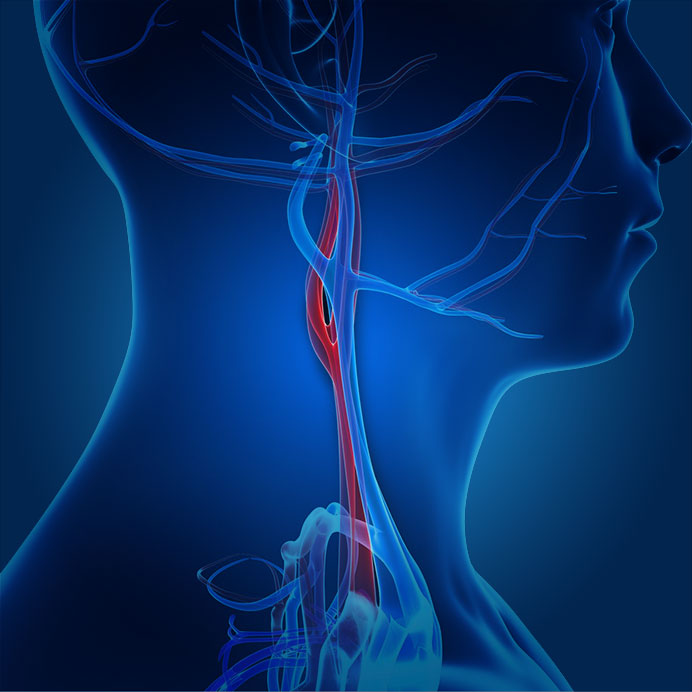Diagnostics
Carotid Artery Ultrasound
Diagnosing
Carotid Arteries
The left and right common carotid arteries branch in the neck into the internal and external carotid arteries. They function to transport oxygenated blood from the left side of the heart to the intracranial and extracranial tissues.
Carotid Artery Disease
Carotid artery disease or carotid stenosis is quite common, impacting approximately five to twenty percent of Americans, varying with age and other risk factors. Carotid artery disease is caused by atherosclerosis, or the gradual accumulation of calcified plaque in the arterial walls. Plaque can eventually restrict or completely block the flow of blood through the arteries, causing a stroke. Stroke can also occur when a bit of the plaque flakes off and embolizes into the brain.
The biggest risk factors for developing atherosclerosis and carotid artery disease include elevated cholesterol and triglycerides, high blood pressure, smoking, chronic inflammation, and family history.
Carotid Artery Ultrasound Examination
Duplex ultrasound examination of the carotid arteries is performed to evaluate for atherosclerotic stenoses and blockages. Carotid arterial duplex ultrasound uses real-time imaging and color Doppler to evaluate the structure and function of the common, external, and internal carotid arteries in about 30 minutes. Because duplex technology allows evaluation of the blood flow as well as the arterial structure, it is considered the gold standard in evaluating the carotid arterial system of the extremities. Because it does not use ionizing radiation, duplex ultrasonography is considered harmless and can be safely used with pregnant patients and patients of any age.There is no required prep and NPO is not necessary.

Indications
- Carotid bruit
- Transient ischemic attack (TIA)
- Stroke
- Aphasia or slurred speech
- Amaurosis fugax
- Syncope
- High-risk individuals – those with diabetes, obesity, smoking history
Common Findings
- Intimal thickening
- Atherosclerosis
- Carotid stenosis or blockage
- Subclavian stenosis
- Subclavian steel syndrome
CPT Codes
-
93880 – Duplex Carotid Artery (complete / bilateral study)
-
93882 – Duplex Carotid Artery (limited / unilateral study)
Common ICD-10 Codes
-
I65.29 – Occlusion & stenosis of unspecified carotid artery
-
R40.4 – Transient alteration of awareness
-
R55 – Syncope and collapse
-
R26.9 – Unspecified abnormalities of gait and mobility
-
R27.0 – Ataxia, unspecified
-
G45.4 – Transient global amnesia
-
H81.49 – Vertigo of central origin, unspecified ear
-
G45.3 – Amaurosis fugax
-
H93.19 – Tinnitus, unspecified ear
-
I69.992 – Facial weakness following unspecified cerebrovascular disease
-
H53.129 – Transient visual loss, unspecified eye
-
H53.2 – Diplopia
-
R41.82 – Altered mental status, unspecified
-
R51 – Headache
-
R47.01 – Aphasia
-
H53.139 – Sudden visual loss, unspecified eye
-
H53.10 – Unspecified subjective visual disturbances
-
R29.5 – Transient paralysis
-
R47.02 – Dysphasia
-
R47.81 – Slurred speech
-
G45.8 – Other transient cerebral ischemic attacks and related syndromes
© 2022 Texas Sonography Associates | Site by JQ

